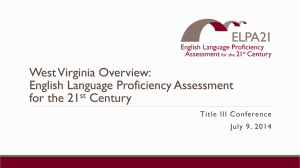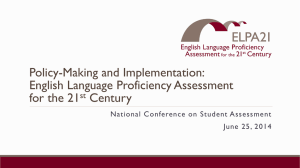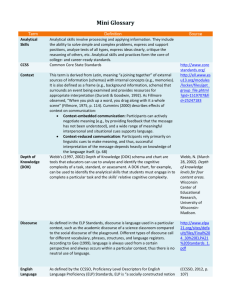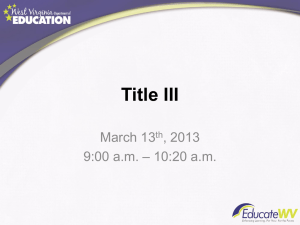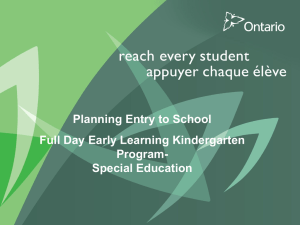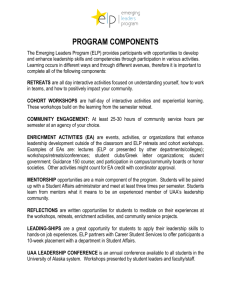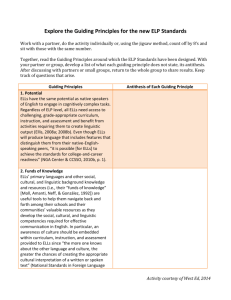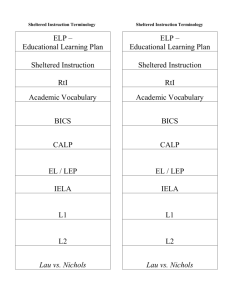Mini-Glossary
advertisement
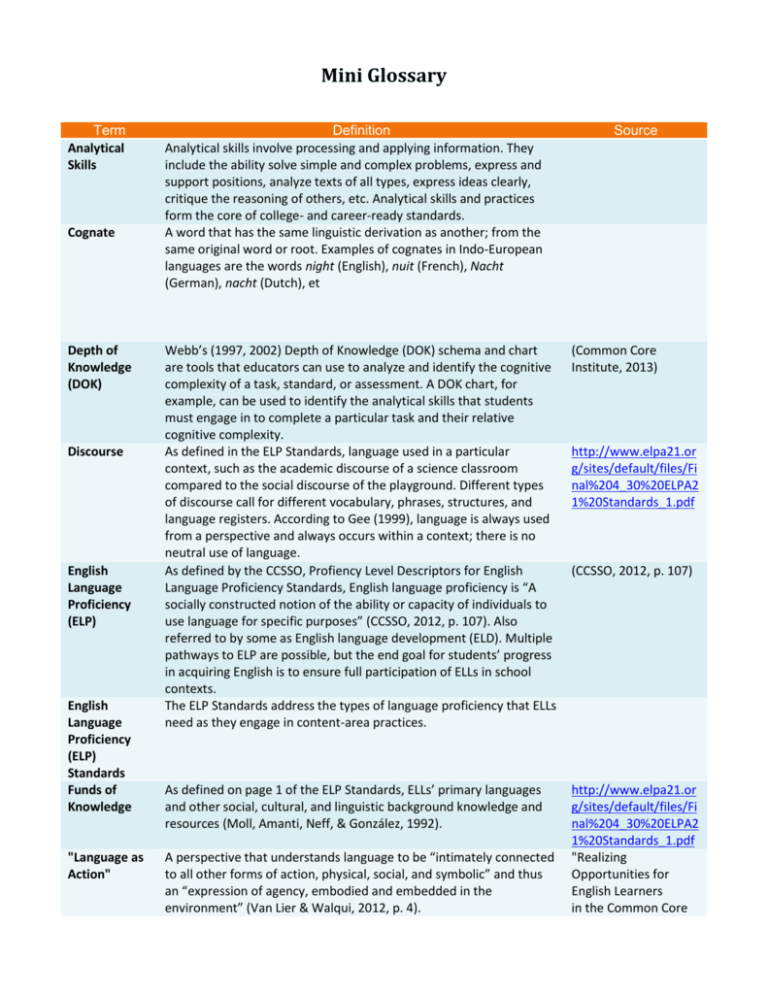
Mini Glossary Term Analytical Skills Cognate Depth of Knowledge (DOK) Discourse English Language Proficiency (ELP) English Language Proficiency (ELP) Standards Funds of Knowledge "Language as Action" Definition Analytical skills involve processing and applying information. They include the ability solve simple and complex problems, express and support positions, analyze texts of all types, express ideas clearly, critique the reasoning of others, etc. Analytical skills and practices form the core of college- and career-ready standards. A word that has the same linguistic derivation as another; from the same original word or root. Examples of cognates in Indo-European languages are the words night (English), nuit (French), Nacht (German), nacht (Dutch), et Source Webb’s (1997, 2002) Depth of Knowledge (DOK) schema and chart are tools that educators can use to analyze and identify the cognitive complexity of a task, standard, or assessment. A DOK chart, for example, can be used to identify the analytical skills that students must engage in to complete a particular task and their relative cognitive complexity. As defined in the ELP Standards, language used in a particular context, such as the academic discourse of a science classroom compared to the social discourse of the playground. Different types of discourse call for different vocabulary, phrases, structures, and language registers. According to Gee (1999), language is always used from a perspective and always occurs within a context; there is no neutral use of language. As defined by the CCSSO, Profiency Level Descriptors for English Language Proficiency Standards, English language proficiency is “A socially constructed notion of the ability or capacity of individuals to use language for specific purposes” (CCSSO, 2012, p. 107). Also referred to by some as English language development (ELD). Multiple pathways to ELP are possible, but the end goal for students’ progress in acquiring English is to ensure full participation of ELLs in school contexts. The ELP Standards address the types of language proficiency that ELLs need as they engage in content-area practices. (Common Core Institute, 2013) As defined on page 1 of the ELP Standards, ELLs’ primary languages and other social, cultural, and linguistic background knowledge and resources (Moll, Amanti, Neff, & González, 1992). http://www.elpa21.or g/sites/default/files/Fi nal%204_30%20ELPA2 1%20Standards_1.pdf "Realizing Opportunities for English Learners in the Common Core A perspective that understands language to be “intimately connected to all other forms of action, physical, social, and symbolic” and thus an “expression of agency, embodied and embedded in the environment” (Van Lier & Walqui, 2012, p. 4). http://www.elpa21.or g/sites/default/files/Fi nal%204_30%20ELPA2 1%20Standards_1.pdf (CCSSO, 2012, p. 107) Language Demands Language Domains Language Forms Language Functions This phrase refers to the “language that students are required to understand and use during a particular task or activity.” Reading, writing, speaking, listening As defined on page 1 of the ELP Standards, language forms are the vocabulary, grammar, and discourse specific to a particular content area or discipline. In this module, we define language forms being made up of language structures and cross-curricular academic vocabulary. As defined on page 1 of the ELP Standards, language functions are what students do with language to accomplish content-specific tasks. Gibbons (1993) refers to language functions as the purposes for which language is used in the classroom. Linguistic Output Refers to the production of language. Educators should provide ELLs with communicative tasks that require students to create the sustained output necessary for second language development. Modalities As defined by the ELP Standards, modalities are the means or manner by which communication takes place. The three modalities are receptive, productive, and interactive. The four language domains of reading, writing, listening, and speaking are contained within these three modalities. Receptive Language Modality Productive Language Modality Refers to a situation where the learner as a reader/listener/viewer is working with "text' whose author or deliverer is not present or accessible” (Phillips, 2008, p. 96). Refers to a situation where the learner is a speaker and/or writer for an audience. According to Phillips (2008) the language or text produced is a planned or formalized speech act or written document that the learner has an opportunity to draft, get feedback, and revise, before publication or broadcast (Phillips, 2008, p. 96). Collaborative use of receptive and productive modalities. This mode refers to the learner as a speaker/listener [AND] reader/writer. It requires two-way interactive communication where negotiation of meaning may be observed. These exchanges provide evidence of awareness of the socio-cultural aspects of communication as language proficiency develops (Philips, 2008, p. 96). The types or levels of language traditionally used in different situations (Some examples of registers are frozen, formal, consultative, casual, intimate). As defined by the ELP Standards, the term practices refers to behaviors which developing student practitioners should increasingly use when engaging with the content and growing in content-area maturity and expertise throughout their elementary, middle, and high school years. Often referred to as “disciplinary practices.” Interactive Language Modality Register (i.e. language register) Practices English Language Arts and Disciplinary Literacy Standards" (Bunch, Kibler, Pimental, 2013) Module 2 http://www.elpa21.or g/sites/default/files/Fi nal%204_30%20ELPA2 1%20Standards_1.pdf http://www.elpa21.or g/sites/default/files/Fi nal%204_30%20ELPA2 1%20Standards_1.pdf (Gibbons, 1993) (See Principle 7 in Principles of Instructed Second Language Acquisition.) http://www.elpa21.or g/sites/default/files/Fi nal%204_30%20ELPA2 1%20Standards_1.pdf (page 7 of the ELP Standards) (Phillips, 2008, p. 96) (Phillips, 2008, p. 96) (Phillips, 2008, p. 96) http://www.elpa21.or g/sites/default/files/Fi nal%204_30%20ELPA2 1%20Standards_1.pdf (p. 212) Science Practices (SP) Mathematical Practices (MP) English Language Arts Practices (EP) Scaffolding Sentence Structures Task Analysis The NGSS Science and Engineering Practices. The practices describe the behaviors that scientists engage in as they investigate and build models and theories about the natural world and the key set of engineering practices that engineers use as they design and build models and systems. The Science and Engineering Practices “describe behaviors that scientists engage in as they investigate and build models and theories about the natural world” (NGSS, 2013). As noted in Appendix F of the NGSS (NGSS Lead States, 2013), chapter three of the Science Framework for K-12 Science Education (NRC, 2012) provides background on the development of the Science and Engineering Practices. For more information and examples, see Bybee (2011). The math practices describe ways in which developing student practitioners of mathematics should increasingly engage with the subject matter as they grow in content-area maturity and expertise throughout their elementary, middle, and high school years. The EPs describe ways in which developing student practitioners of ELA should increasingly engage with the subject matter as they grow in content-area maturity and expertise throughout their elementary, middle, and high school years. The practices are student actions, not teaching practices. Developed for the ELPD Framework for CCSS by ELA writer Susan Pimentel as analogous to the existing mathematics and science & engineering practices, but not found in the original CCSS for ELA. As defined in Appendix A of the CCSS ELA & Literacy Standards, this refers to guidance or assistance provided to students by a teacher, another adult, or a more capable peer, enabling the students to perform tasks that they otherwise would not be able to perform alone, with the goal of fostering the students’ capacity to perform the tasks on their own later on. Pedagogically, a scaffold is the support offered to students so that they can successfully engage in activity beyond their current ability to perform independently. As defined in the ELP Standards and the Proficiency Level Descriptors, sentence structures include simple, compound, complex sentences, and the range of other sentence structures. This is a structured process by which educators unpack an academic task to identify the knowledge and skills students will be required to demonstrate in order to perform the task successfully. http://www.elpa21.or g/sites/default/files/Fi nal%204_30%20ELPA2 1%20Standards_1.pdf (Bybee, 2011) http://www.elpa21.or g/sites/default/files/Fi nal%204_30%20ELPA2 1%20Standards_1.pdf http://www.elpa21.or g/sites/default/files/Fi nal%204_30%20ELPA2 1%20Standards_1.pdf http://www.elpa21.or g/sites/default/files/Fi nal%204_30%20ELPA2 1%20Standards_1.pdf http://www.elpa21.or g/sites/default/files/Fi nal%204_30%20ELPA2 1%20Standards_1.pdf Module 2
